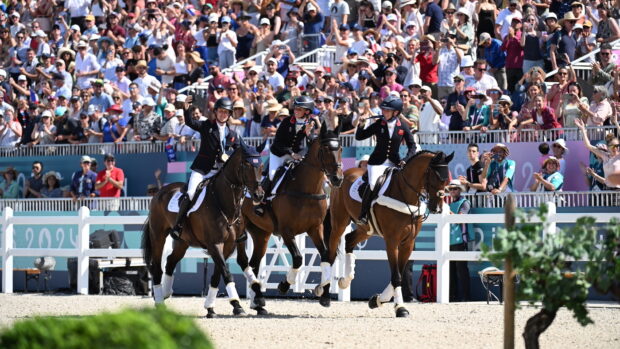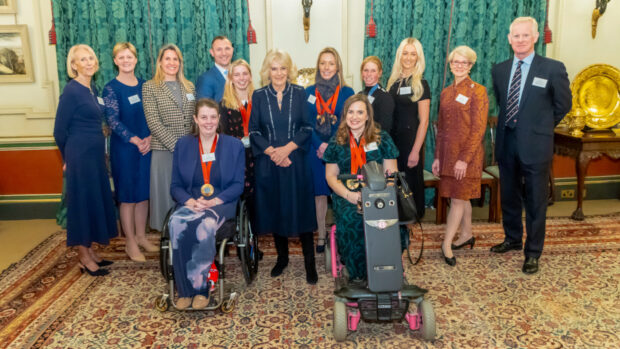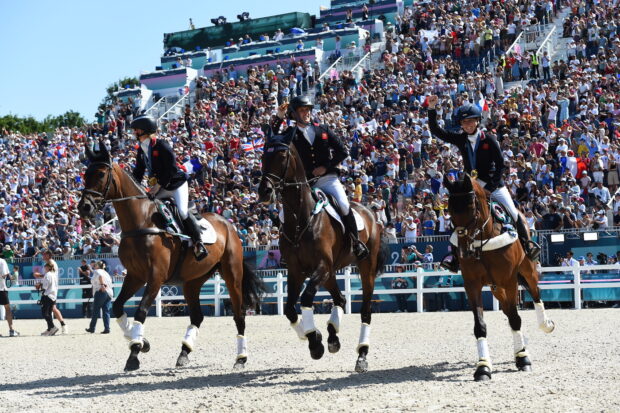While you’re watching the para dressage at the Paris Paralympics, you might find yourself wondering, “Why is there another horse in the arena?”
These unsung heroes are known as “companion horses” or more often – and more endearingly – as “friendly horses” and play a vital role at the Paralympics in keeping the competing horse calm and the rider safe.
But they’re more than a practical measure, they’re also a testament to the collaborative spirit and traditions that have been a part of para dressage since its inception at the Atlanta Games in 1996.
Back then, the athletes were competing on borrowed horses which were drawn on lots upon arrival at the venue.
Britain’s Anne Dunham, who won team gold and grade II individual bronze in Atlanta, recalled arriving at the Games, digging her hand into a hat and drawing out the name of the horse she would compete – which turned out to be a horse called Doodlebug.
“He was a riding school pony who really did behave like a doodlebug in the arena!” remembers Anne, who added that she “actually really liked” competing on the borrowed horses.
“I didn’t have my own horse until I was in my 40s anyway, and I worked at riding schools, always riding whatever was left over or came my way,” she told H&H. “I was very used to riding anything and everything.
“We would see the horses being paraded and we all daydreamed about the one we would choose, but we’d almost never get it.
“We had an hour a day to ride our allotted horse in the run-up to the competition, which was only a couple of days.
“It was a challenge, but I thought it was great fun, and it brought about a huge sense of camaraderie, which still exists in the sport today.”

From the archives: The Horse & Hound report from September 1996 on para dressage’s first-ever appearance at the Paralympics.
Like Doodlebug, most of these borrowed horses came from local riding schools and weren’t used to working in an arena alone.
To help keep them calm organisers allowed a “friend horse” to accompany them into the arena. In Atlanta, the horse that had just completed its test would often stay in the arena to provide company to the next competitor.
While at the 2004 Athens Games local therapy horses were enlisted to stand in the arena throughout the competition alongside volunteer handlers.
The sport has come on leaps and bounds since then, and now teams can bring their own companion horse. However, it’s not uncommon for horses to be shared between countries – keeping that spirit of camaraderie alive.
The rules for the “friendly horses” at the Paris Paralympics
Today, a companion horse is permitted to enter the arena with the competing horse at grades I, II and III.
The companion horse can be held in hand within the field of play but outside the white boards.
In the past, competitors could choose where to position the companion horse, sometimes strategically placing them in challenging spots or spooky corners to give the competing horse added confidence.
Now, however, the area they stand in must be designated by the president of the ground jury prior to the start of the competition. Typically, this is at the A end of the arena, to give the horses extra confidence when they’re entering.
This will be particularly important in Paris, where the atmosphere is likely to be much more intimidating than most the horses are used to – with the equestrian venue at Versailles one of the first two Paralympic venues to sell out.
Companion horses can wear a bridle, and if needed, a rug but no saddles or other adornments like advertisements are allowed.
- To stay up to date with all the breaking news throughout the Paralympic Games, Burghley, Horse of the Year Show and more, subscribe to the Horse & Hound website
You might also be interested in:

British Paralympic dressage team for Paris 2024 announced: who’s heading to Versailles?

Read +120 years of Horse & Hound in new online magazine archive

Subscribe to Horse & Hound magazine today – and enjoy unlimited website access all year round






